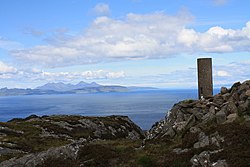Eilean Shona
| Eilean Shona Gaelic: Eilean Seòna | |
 The summit cairn and trig on Eilean Shona's highest point The islands of Eigg and Rum are in the background. | |
|---|---|
| Location | |
| Location: | 56°48’-0"N, 5°51’36"W |
| Grid reference: | NM645739 |
| Area: | 1,297 acres |
| Highest point: | Beinn a' Bhàillidh, 870 ft |
| Data | |
| Population: | 2 |
Eilean Shona is a tidal island of Inverness-shire in Loch Moidart. The modern name may be from the Old Norse for "sea island". The pre-Norse Gaelic name, as recorded by Adomnán was Airthrago or Arthràigh, meaning 'foreshore island', similar to the derivation of Erraid.[1]
It was leased to writer J. M. Barrie in the 1920s, who used it as a summer holiday retreat for himself, his foster sons Michael and Nicholas Llewelyn Davies, and a few of their friends.[2] It was here he wrote a screenplay for the 1924 film adaptation of Peter Pan.
In 1851 there were reports of evacuations and emigrations of 37 families from the island and the nearby settlement of Dorlinn in the wake of potato blight.[3] In 1856 the sale price of the island was just £6,500. Until the middle of the 18th century, Eilean Shona was populated with a number of crofters. The main house was a small hunting lodge owned, in the middle of the 19th century, by a seafaring Captain Swinburne. He collected numerous types of pine on his travels and established what became one of the most diverse Pinetum's in Europe. At the end of the 19th century Robert Lorimer, who planned much of Edinburgh's New Town, was commissioned by the island's owner, a Mr Thompson, to remodel the main house, doubling its size.
In the 1930s Eilean Shona was given to Lady Howard De Walden as a wedding present by her future husband. During this period numerous improvements to the island, particularly to the grounds and gardens, were made at the beginning of the 20th century by the De Walden family
Mr and Mrs Digby Vane bought the island in 1962 and sold it to the Stead family in 1982. The island has belonged to the Devereux-Branson family since 1995. Vanessa Branson and Robert Devereux purchased the island in 1995 for a sum believed to be in the region of £1.3 million.[4] The current usually resident population is 2, down from 9 in 2001.
Other isles in the loch include Riska Island, Eilean an Fhèidh and Eilean Tioram. Eilean Shona House overlooks Riska and Castle Tioram. The old Schoolhouse (on the North Shore track between Sawmill and Baramore) is in an isolated position, some two miles down a track, reputedly because when it was built in the nineteenth century the wife of the island's owner did not wish to be disturbed by children.[4]
The peninsula of Shona Beag is accessible from the mainland by a short causeway at low tide (grid reference NM 669 739). Eilean Shona is one of 43 tidal islands that can be walked to from the mainland of Great Britain and one of 17 that can be walked to from the Scottish mainland.[5]
References
- ↑ Watson, W. J. (1994) The Celtic Place-Names of Scotland. Edinburgh; Birlinn. ISBN 1841583235. First published 1926. pp. 75-76
- ↑ Birkin, Andrew, The Lost Boys, (Yale University Press)
- ↑ Moidart.org Retrieved 9 July 2007.
- ↑ 4.0 4.1 Haswell-Smith, Hamish. (2004) The Scottish Islands. Edinburgh. Canongate.
- ↑ Caton, Peter (2011) No Boat Required - Exploring Tidal Islands. Matador.
Outside links
| ("Wikimedia Commons" has material about Shona Eilean Shona) |
